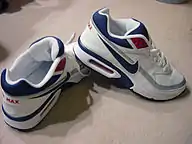Nike Air Max
Nike Air Max is a line of shoes produced by Nike, Inc., with the first model released in 1987. Air Max shoes are identified by their midsoles incorporating flexible urethane pouches filled with pressurized gas, visible from the exterior of the shoe and intended to provide cushioning underfoot. Air Max was conceptualized by Tinker Hatfield, who initially worked for Nike designing stores.[1]
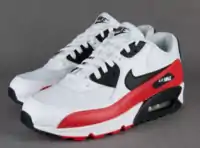 | |
| Type | Sneakers |
|---|---|
| Inventor | Nike, Inc. |
| Inception | 1987 |
| Manufacturer | Nike |
| Website | nike.com/air-max-shoes |
Overview
As the name indicates, all Air Max shoes feature one or more translucent pouches of pressurized gas embedded in the midsole and visible from the outside of the shoe. Referred to as "Air units" or "airbags," their stated purpose is to provide superior cushioning to traditional foam while also reducing weight. The effectiveness of the technology for this purpose is disputed; nevertheless, the shoes enjoy consistent popularity, especially among sneaker enthusiasts and collectors.
The size, design, and number of air units varies within the product line; the "retro" Air Max 1 simply includes one small unit under the heel, while in the contemporary Air VaporMax, effectively the entire midsole is composed of air units with no conventional foam present.
Culture and fashion
The line of sneakers is popular amongst many subcultures, for example hip hop and gabber.
In the mid-1990s the line, especially the Air Max 95 model, experienced such a surge of popularity in Japan that it led to a phenomenon known as "Air Max hunting". The extremely inflated prices of the shoes led to a rash of muggings in the normally-peaceful country wherein Air Max wearers were attacked and their shoes were stolen. Even used shoes were in demand, and fakes also became a serious problem.[2]
Models
Air Max 1
Released in 1987 as simply the Air Max, the Air Max 1 was the first shoe ever to employ Max Air technology.[3] It was marketed for running, which would continue to be the case for new Air Max designs until 2018's Air Max 270. Its upper was composed of nylon and synthetic felt, with a leather version being released in 1988. The Air Max 1 continues to enjoy significant popularity with sneaker enthusiasts, with Nike releasing "retro" models employing both original and pre-existing exterior designs ("colorways") on a regular basis.. The Air Max 1 between 2018 and 2019 has been released as a golf shoe type called the Air Max 1G.
Air Max Light
Released in 1989 as the Air Max II, the Air Max Light weighed less than the original, achieved by replacing the forefoot polyurethane midsole with one made of EVA foam. Re-released in 2007, Nike has continued to release additional colorways.
Air Max 90

Known as the Air Max III until 2000, when it was reissued taking its name from the year of its launch. The original colourway of white/black/cool grey with infrared was chosen to exaggerate the thickness of the sole air cushion. The upper featured Duromesh, synthetic felt and synthetic leather. Nike specially designed a pair of Nike Air Max 90s for President George H.W. Bush. Images of the customized sneakers have been seen around the Department of Nike Archives, and feature AIR PRES branding along with what appears to be a unique colorway.
Air Max 180
Released in 1991, the Air Max 180 featured a larger air unit visible through the outsole. The technology was later used in the Air Force 180 sneaker.[4]
Air Max 93
Released in 1993 as the Air Max 270, the Air Max 93 introduced a 270-degree air unit and colored air units to the range. Nike employed a new manufacturing processes to provide the larger and more exposed air unit greater protection. The upper featured a more sock-like fit derived from 1991's Air Huarache sneaker.[5]
Air Max 95
The visual design of the Air Max 95 was created by Sergio Lozano, who based the design of the Air Max 95 on the human anatomy, with the spine of the shoe resembling the human spine and the materials intended to represent skin, ribs, and tendons.[6] The Air Max 95 was the first pair in the line to utilize two air cushions in the forefoot and used air pressure technology to fit the curvature of the wearer's forefoot.[7] The first colorway was black, neon yellow and white. Neon yellow was used to emphasize the multiple air units. The shoe also introduced a smaller Nike swoosh minimized in the rear side panel. Original releases featured a "25 PSI" air pressure reading on the rear air unit. Uppers also featured 3M Scotchlite material.[8]
The product was referenced in the hip hop song "Hate It or Love It" by The Game, which was a worldwide top 10 hit in 2005. Also referenced by rappers Gucci Mane in the hit single "Bricks" and Waka Flocka Flame on the track "Head First" in his 2009 mixtape, "Lebron Flocka James". The rapper Eminem designed a limited-edition range of Air Maxes sold for charity.[9]
Air Max 97
1997's Air Max 97 was inspired by high-speed Japanese bullet trains.[10] It was introduced with a sleeker, metallic silver colorway that contained a nearly full-length visible air unit. Uppers feature three reflective lines made of 3M Scotchlite material.
The Nike Air Max 97 is a Nike running shoe designed by Christian Tresser. It was inspired by Japan's high-speed Bullet Trains and features a mix of leather, foam, and full-length visible Air. The original “Silver Bullet” colorway released again in the US on April 13th, 2017 for $160. Over 13 new colorways are hitting retailers starting August 1st, 2017.
Some of the colorways are Khaki, White/Red, Tea Berry, Metallic Silver, B-sides Pack, Guava Ice, True Brown, Pittsburgh Steelers, Phantom, Red/White/Blue, Just Do It, Elemental Pink, Desert and Sky, Luxurious Tan, Ocean Bliss, Midnight Navy, Tartan, Mustard, and Metallic Gold.
Air Max Plus Tuned
Released in 1998, the Air Max Plus introduced Nike's Tuned Air system.[11] It is often referred to as the Air Max TN. Designed by Sean McDowell, the Air Max Plus featured transverse waves inspired by palm trees, and a prominent arch shank inspired by a whale tail. The initial release featured a "Hyper Blue" colorway, characterized by a fading blue airbrush effect. The Nike swoosh had a slightly irregular appearance as a border was added along the inner edge, as opposed to the outer surface.[12]
Air Max 360
On January 21, 2006 Nike launched the Air Max 360, a new shoe design that utilized Max Air throughout the shoe's midsole. In September 2006 Nike introduced a special 'one time only pack' which fused the 360 model with three classics. The three shoes used were the Air Max 90, Air Max 95, and Air Max 97. For this special release, the design of the 360 sole was used in place of the normal sole of the three classics. The shoes were released in the three original colors: red for the Air Max 90, green/yellow for the Air Max 95, and grey/silver for the Air Max 97. Like other Air Max releases, deluxe editions were also produced. These deluxe editions lasted for about 500 miles (800 km) before their shock-absorbing properties deteriorated. The use of '360' of air cushioning is meant to ensure the shoe's longevity.
Air VaporMax
The Air VaporMax released in March 2017, and was the first Air Max shoe to use no foam or rubber whatsoever in the midsole or outsole.[13] It discarded a traditional midsole/outsole design and in place used several entirely hollow air pouches, not connected to one another and positioned in different areas in accordance with where the wearer's foot would naturally strike. The VaporMax sole itself has not been significantly innovated upon since its initial release, but original shoes using the sole design continue to be released, including several "hybrids" which fuse a VaporMax sole with the upper design of an older Air Max shoe such as the Air Max 95, 97, and 360.
Air Max 270
The shoe was originally released on February 1, 2018. It was named "270" for the 270 degrees of visibility in the Air unit around the shoe, and was inspired by the Air Max 93 and 180 shoes.[14] It was the first Air Max shoe to be designed for lifestyle purposes rather than running.[14] It also was the tallest Air unit to ever be released at the time, measuring 32 mm tall.[14]
Air Max 720
One year after the Air Max 270, Nike debuted their second Air unit to be designed for lifestyle purposes with the Air Max 720. As opposed to the heel-only 270 Air unit, the 720 Air unit extends under the forefoot, and is also taller than the 270 by 6mm. New colorways of the Air Max 720 and additional designs based on its Air unit, including the basketball-inspired Air Max 720 SATRN and a hybrid based on the retro Air More up-tempo, continue to be released.
Advertising
The shoes were initially advertised in 1987 with a TV campaign that used the Beatles' song "Revolution", the first time a Beatles song had been used in a TV commercial.[15] The following year, Nike used the Just Do It slogan.[16] They were also endorsed by Bo Jackson in exchange for a $100,000 fee, with advertising agency Wieden and Kennedy coming up with the slogan "Bo knows...".[17] Tom Holland wears white and blue Air Max 1 while portraying Peter Parker / Spider-Man in the 2019 film Spider-Man: Far From Home.
Model history
Air Max models launched include:
- Air Max (commonly known as Air Max 1) - 1987
- Air Stab - 1988
- Air Max II (commonly known as Air Max Light) - 1989
- Air Max III (commonly known as Air Max 90) - 1990
- Air Max IV (Air Max BW, Air Max Classic or Air Classic BW) - 1991
- Air Structure Triax 91 - 1991
- Air 180 (now known as Air Max 180) - 1991
- Air Max ST - 1992
- Air Tailwind 92 - 1992
- Air Max 93 (also known as Air Max 270) - 1993
- Air Max 94 - 1994
- Air Max 2 - 1994
- Air Max 2 Light - 1994
- Air Max 2 Charles Barkley 34 (commonly known as Air Max CB 34) - 1994
- Air Max 2 Charles Barkley 94 (commonly known as Air Max CB 94) - 1994
- Air Max Triax 94 - 1994
- Air Max Light 2 - 1994
- Air Total Max (commonly known as Air Max 95) - 1995
- Air Max Racer - 1995
- Air Max 96 - 1996
- Air Max 96 II
- Air Max Tailwind II - 1996
- Air Max 97 - 1997
- Air Max 98 - 1998
- Air Max 98 TL - 1998
- Air Max 99 - 1999
- Air Max Pillar
- Air Max Posterize SL
- Air Max Tailwind III - 1998
- Air Max Plus Tuned - 1998
- Air Max Plus Tuned II - 1999
- Air Max Tuned - 1999
- Air Max Tuned Precision - 1999
- Air Max Deluxe - 1999
- Air Max Tailwind IV - 1999
- Air Max 120
- Air Max 2000 - 2000
- Air Max Metal - 2000
- Air Max Alesco - 2000
- Air Max International - 2000
- Air Max Metal IV - 2000
- Air Max Plus Tuned III - 2000
- Air Max Tailwind V - 2000
- Air Max Tailwind VI - 2001
- Air Max Specter - 2001
- Air Max Multiple - 2002
- Air Max Ltd - 2002
- Air Max Elite R - 2003
- Air Max 2003
- Air Max 2004
- Air Max Destined - 2006
- Air Max 360 - 2006
- Air Max 180 - 2006
- Air Max 360 - 2007
- Air Max 180 II - 2008
- Air Max Elite
- Air Max 180 III - 2008
- Air Max T-Zone - 2009
- Air Max Skyline
- Air Max 2009
- Air Max 90 Current - 2009 (redesign of the Air Max 90, incl. toe box)
- Air Maxim - 2009 (redesign of the Air Max 1, featuring Flywire or torch materials)
- Air Max BW Gen II - 2010 (redesign of the Air Max BW, featuring torch material)
- Air Max 2010
- Air Max Tailwind+ 2
- Air Max Trainer 1
- Air Max Trainer 1+ (with Flywire, toe strap, and 360 Air Max Technology)
- Air Max Turbulence - 2010
- Air Max 2011
- Air Max Command
- Air Max 24/7
- Air Max+ 2012
- Air Max+ 2013
- Air Max Defy Run
- Air Max Minot
- Air Max Motion
- Air Max+ 2014
- Air Max Direct
- Flyknit Air Max
- Air Max Zero
- Air Max Prime
- Air Max Tavas
- Air Max+ 2015
- Fingertrap Max
- Air Max+ 2016
- Air Max+ 2017
- Air Max invigor
- Air Max 95
- Air Max Torch IV
- Air Max 97 OG[18]
- Air Max 270
- Air Max 720
- Air Max Axis
- Air Max 2090 (Nov 2020)
The 1993 model was the first to have the fully visible heel Air unit that was visible in the back as well as on the sides, and the 1995 model was the first to feature visible forefoot Air. The 1997 model was the first to include a full-length Air bag.
Gallery
 Air Max 5 CL
Air Max 5 CL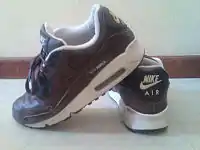 Leather Air Max 90s
Leather Air Max 90s.jpg.webp) Air Max 90 360 hybrid (2006) next to the original Air Max 90 (1990) in the original "Infrared" colorway
Air Max 90 360 hybrid (2006) next to the original Air Max 90 (1990) in the original "Infrared" colorway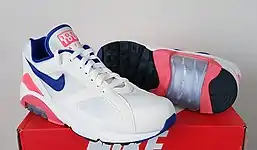 Air Max 180 in the original 1991 "Ultramarine" colorway. Visible air unit in the sole
Air Max 180 in the original 1991 "Ultramarine" colorway. Visible air unit in the sole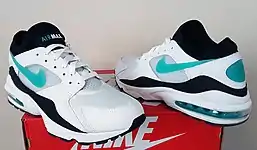 Air Max 93 in the original "Cactus" colorway. Visible air unit around the heel
Air Max 93 in the original "Cactus" colorway. Visible air unit around the heel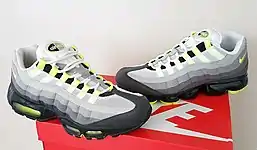 Air Max 95 (1995) next to the Vapormax 95 Hybrid (2018) in the original "Neon" colorway
Air Max 95 (1995) next to the Vapormax 95 Hybrid (2018) in the original "Neon" colorway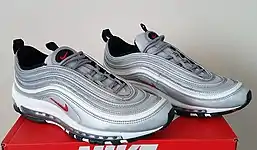 Air Max 97 in the original "Silver Bullet" colorway
Air Max 97 in the original "Silver Bullet" colorway
 Air Max Plus in the original 1998 "Hyper Blue" colorway. Tuned Air system visible in the outsole
Air Max Plus in the original 1998 "Hyper Blue" colorway. Tuned Air system visible in the outsole.jpg.webp) Nike Air Max Plus Tuned (2018)
Nike Air Max Plus Tuned (2018) 2006 Nike Air Max 360
2006 Nike Air Max 360 Air VaporMax Flyknit 2.0
Air VaporMax Flyknit 2.0 Air Max 270 in the "Sail Lilac" colorway, showing the flexibility of the Air unit
Air Max 270 in the "Sail Lilac" colorway, showing the flexibility of the Air unit Air Max 720 in the debut "Northern Lights Night" colorway
Air Max 720 in the debut "Northern Lights Night" colorway
References
- Reidy, Tess (December 14, 2013). "Nike's iconic Air Max trainer celebrates 25th anniversary with Tinker Hatfield". The Guardian (UK). Retrieved December 23, 2013.
- Lev, Michael A. (November 17, 1996). "'Air Max Hunting' Shocks Japan -- Holdups, Beatings Blamed On Mania For Used Sneakers". The Seattle Times. Retrieved July 4, 2015.
- https://www.goat.com/editorial/nike-air-max-sneakers-history
- Styles, Unorthodox (2005). Sneakers: The Complete Collectors Guide. Thames & Hudson. ISBN 0500512159.
- Styles, Unorthodox (2005). Sneakers: The Complete Collectors Guide. Thames & Hudson. ISBN 0500512159.
- Cult Edge - Nike Air Max 95 Colorway Guide
- http://solecollector.com/news/nike-air-max-history/
- Styles, Unorthodox (2005). Sneakers: The Complete Collectors Guide. Thames & Hudson. ISBN 0500512159.
- "People: Eminem, Gong Li, Keith Richards - Arts & Leisure - International Herald Tribune". New York Times. Retrieved December 23, 2013.
- Styles, Unorthodox (2005). Sneakers: The Complete Collectors Guide. Thames & Hudson. ISBN 0500512159.
- Styles, Unorthodox (2005). Sneakers: The Complete Collectors Guide. Thames & Hudson. ISBN 0500512159.
- https://hypebeast.com/2017/11/nike-air-max-plus-tn-sean-mcdowell-interview
- A Brief History Of The Nike Air Max Series, Complex. 《》, MAR 23, 2017.
- "Eight Things You Should Know About the Nike Air Max 270". Nice Kicks. Retrieved March 4, 2020.
- Wong, Glenn M (2012). The Comprehensive Guide to Careers in Sports. Jones & Bartlett. p. 232. ISBN 9781449602031.
- Carbasho, Tracy (2010). Nike. ABC-CLIO. p. 15. ISBN 9781598843439.
- Cashmore, Ellis; Ernest Cashmore (2010). Making Sense of Sports. Taylor & Francis. p. 423. ISBN 9780415552202.
- Air Max 97 OG Relaunch
